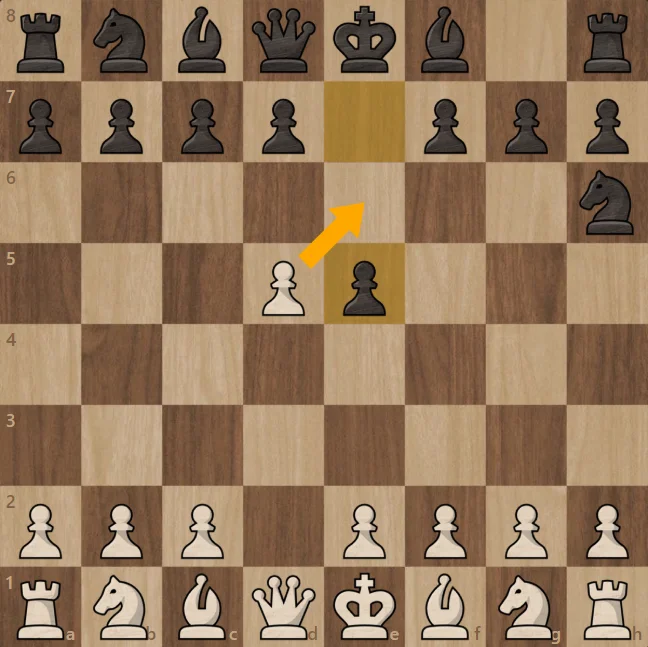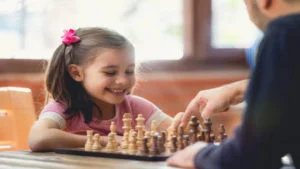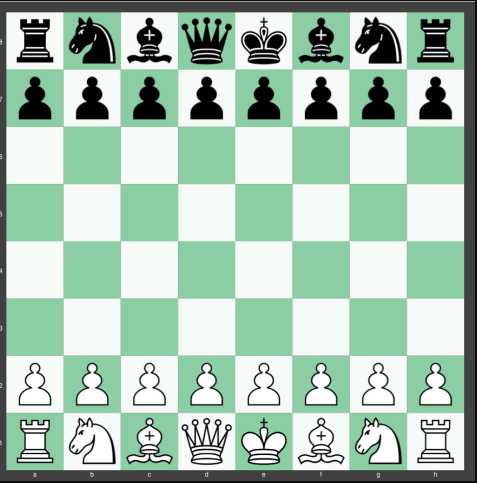Chess is one of the world’s most popular board games, that is played between two players. The current version of the game appeared in Southern Europe in the 15th century. However, its origin is from a similar, but much older game from India. This is a beginner’s guide to playing chess. Read on to find out more!
What is chess?
Chess is an abstract strategy game. The objective of the game is to checkmate the opponent’s king. This implies that the king piece is under check or immediate attack. However, there are times when the game can end in a draw. Chess is an abstract strategy game and involves no hidden information. It is played on a square chessboard with 64 squares arranged in an eight-by-eight grid. At the start, each player (one controlling the white pieces, the other controlling the black pieces) controls sixteen pieces: one king, one queen, two rooks, two knights, two bishops, and eight pawns. The object of the game is to checkmate the opponent’s king, whereby the king is under immediate attack (in “check“) and there is no way for it to escape. There are also several ways a game can end in a draw.
What do you need to play chess?
There are only a few requirements to play the game of chess. You will need,
1. A chessboard
2. Chess pieces
3. A chess clock if the players decide to play a timed game
4. A sheet of paper to record the score of each player
Of the above-mentioned items, only a chessboard and pieces are essential.
Chessboard
A chessboard is a square in shape and contains rows of squares in alternating colours, usually black and white. A chessboard contains a total of 64 black and white squares.
Chess pieces

There are six kinds of chess pieces namely, the pawn, the bishop, the rook, the knight, the king and the queen. Players can distinguish their troops by colour with light or dark pieces. Generally, the light side is called white and the dark one, black. This nomenclature came about as people used to use pieces made of ivory and ebony to play in the past. reminiscent of the black ebony and white ivory pieces used in the past.
Each chess piece has a distinct value. Pawns are worth one point, bishops and knights are three points, capturing rooks give you five points while the queen gives nine points.
The king is the most valuable piece as it determines if the player loses or wins.
Set up of the chessboard
The first stop of playing chess is setting up the board. When properly set up, a white square will be the rightmost one along the edge nearest to each player. The chess pieces are set up in two horizontal rows. The second row or second rank (from the player) consists of eight paws, each place don a square. The first row contains a symmetrical arrangement on the left and right sides. The pieces must be arranged as follow, the rook on the leftmost and rightmost corner square, the knights placed beside the rooks and then then the bishops. The king and queen are placed on the centre squares. The queen on the square matching her colour and the king on the opposite one.
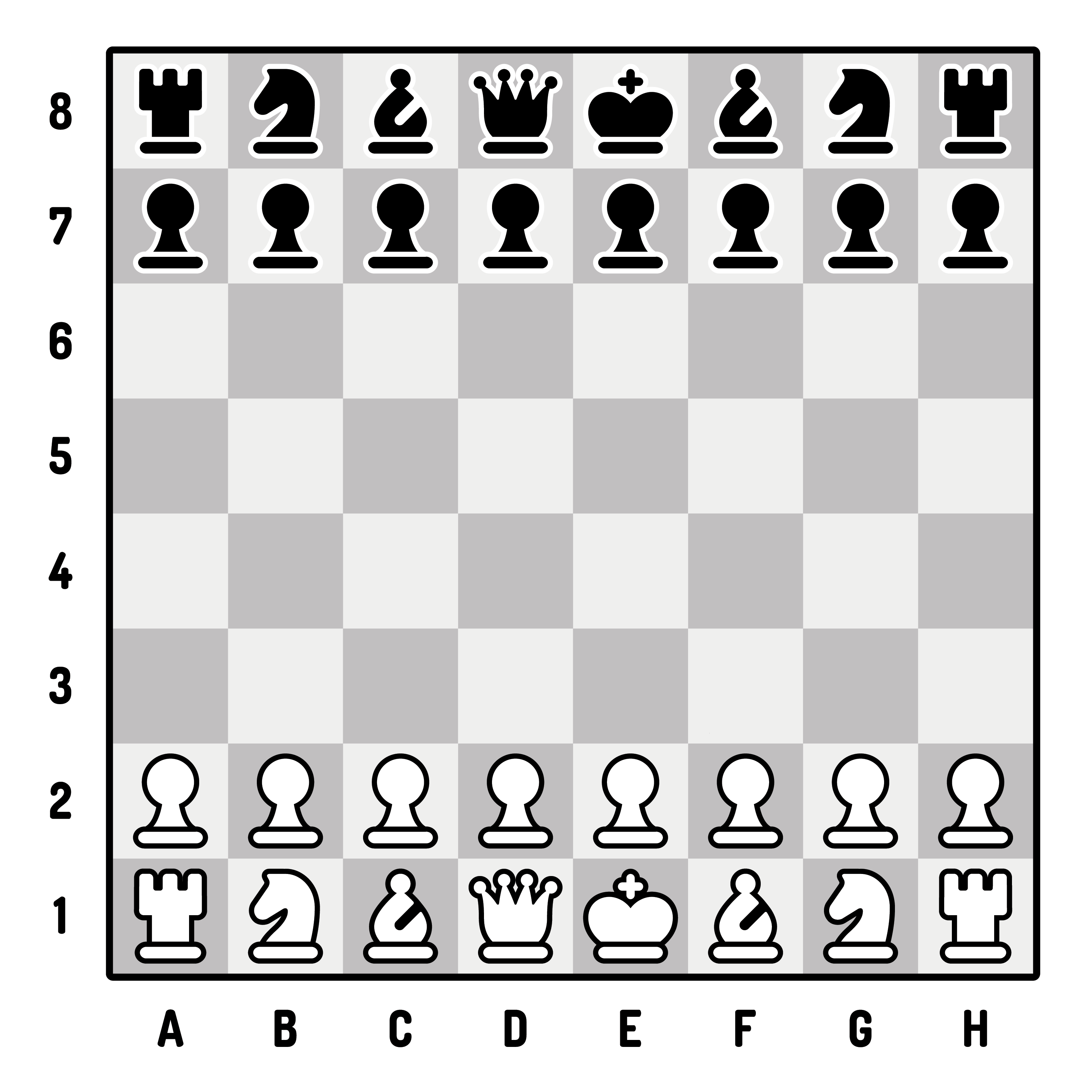
What are the basic rules of chess?
The white player begins the game. Then each player takes turns to make a move. Each chess piece moves in a very specific way. A player must have his or her pieces accordingly while playing chess.
How to capture pieces
During the game, players must try and capture their opponent’s piece. To do so, the player must move to the square containing the opposing player’s chess piece. Once captured, the piece must be removed from the board.
How to move chess pieces

Pawn
Pawns move one square at a time, only in a vertically straight line. They can not move horizontally, backwards or diagonally. However, when a pawn is capturing the opponent’s piece, it may move diagonally right or left, but ahead of the piece. The pawn will then move into the square of the opponent and replace the captured piece.
Rook or Castle
The rook, also known as the castle, can move any number of squares along its row or column. However, it can not pass through pieces of the same colour. Additionally, it can capture pieces of the opposing player by moving onto its square. A rook cannot move diagonally.
Knight
Unlike the previous two pieces, a knight can move through other pieces by jumping over them, although it can not land on the space occupied by a piece of the same colour. Knights move in an ‘L-shaped pattern. This means it moves two squares forward, backward, right or left, then one square horizontally or vertically, one square forward, backward, right or left and lastly, two squares horizontally or vertically to form an L shape. Furthermore, a knight always alternates between the two colours. This means, if a knight starts on a white square it will end up on a black square after completing its legal movement.
Bishop
The bishop can move any number of squares diagonally through squares of the same colour. However, it cannot move vertically or horizontally. A bishop cannot move vertically or horizontally and it cannot pass through a piece of the same colour.
Queen
A queen is not restricted by direction. It can move any number of spaces vertically, horizontally or diagonally. However, these movements must be a single straight line during a single turn. Thus, the player may not change the direction of movement while playing.

King
Unlike the queen, a king can only move one square vertically, horizontally and diagonally. The king cannot be moved into a space that would allow a check or checkmate.
t’s next turn.
Check and checkmate explained

A check refers to the time when a player’s king is under attack. Thus, the opposing player must protect the king by moving it out of the opponent’s range. However, if the attacked player is unable to do so, the king is in checkmate and they lose the game. Checkmate is the ultimate objective of chess.
What are the advanced rules of chess?
Apart from the above mentioned basic rules, chess also has a few advanced or special rules. These rules may alter the core rules of the game and its surrounding environment. Thus, it is often used in tournaments. As this is a beginner’s guide on how to play chess, we will only discuss the special rules.
Promoting a pawn
If a pawn reaches the opposite end of the board it is promoted to another piece. It can be a knight, bishop rook or queen. The new piece replaces the pawn and follows its respective movement rules.
Although most players promote pawns to captured pieces, in reality, it can be replaced with any piece, even if it is not captured. For example, a player may have several queens or bishops as a result of promoting pawns. Additionally, another thing to note is that there is no limit to the number of pawns that can be promoted.
En passant capture
En passant capture is an extremely famous movie. This move occurs during the special circumstance when a pawn moves two squares as its original starting movie. If your pawn could’ve captured the opponent’s pawn if it had only moved one space instead of two, then you can declare an En passant and move diagonally to capture the pawn, as if it had only moved one square.

Castling
Castling is one of the most complicated rules in chess. It occurs when a player’s king and rook have not yet moved during the game. In other words, the pieces are still in their starting positions. Due to the rule, the player must move their king two squares towards the rook and the rook to the space that the king moved through. Thus, the rook is now adjacent on the other side of the king and the king is in the space of the rook.
Something to remember is that the king cannot be used in a casting move if it is or will be in check. Furthermore, castling can also not be used if there are pieces between the king and the rook.
Some common chess tactics
Tactic refer to short-term calculated series of moves that result in checkmate. Learning the basic tactics will help you take advantage of your opponent’s missteps as well as help you avoid making some of your own. There are four tactics that every chess player must know.
Fool’s Mate
This is the fastest way to checkmate. This move can not be forced. For the move to occur, the white player has to start the game by moving one pawn one space forward and the other one next to it two spaces forward.

Forks
This move involves taking out two pieces at one go in a single move. Knight are the best piece for this.
Pins
A player may also ping their opponent using the rooks, bishops and queen.
Skewers
This move is opposite to a pin. It occurs when a player forces a valuable piece to move and the rival opponent leaves a lesser piece open to an attack.
Some strategies to help win the game
Chess includes a variety of concepts, the value of the pieces to evaluating its positions. Learning these principles will greatly improve your game.
Some easy strategies to learn include,
1. The Ruy Lopez, a great way to utilize the complete board. This opening is indicated by the moves,
- e4 e5
- Nf3 Nc6
- Bb5
2. Sicilian Defense is a strategy that relies on one move, e4 c5. It is a classic response to White’s first move of 1.e4.
You can also try more unusual openings like The Sokolsky, Center Game, Bird’s Opening, Elephant Gambit, which will provide an early advantage.
FAQs
Does playing chess increase IQ?
Studies have shown that chess can increase a student’s overall IQ scores. The Venezuelan study involving 4,000-second grade students discovered a significant boost in IQ scores only 4.5 months after they began systematically studying chess. Furthermore, tournament chess games, hone the player’s ability to perform under pressure, simulating the environment of most school, university and competitive exams.
It helps prevent Alzheimer’s disease
The brain is a muscle. Therefore, like any other muscle, it must be exercised for optimum function. Chess provides an excellent exercise for the brain. Several studies found that people over 75 who involve themselves in brain stimulation activities such as chess are less likely to develop symptoms of dementia.
Simply put that unused brain tissue leads to a loss of brainpower.
It increases creativity
As the right hemisphere of the brain is responsible for creativity, activating it helps develop your creative side. Chess greatly increases creativity and originality. A study by Robert Ferguson involved kids from grades 7 to 9 playing chess at least once a week, for 32 weeks. This group proceeded to score higher in all measures of creativity.
It improves your memory
A good chess player must not only remember how the opponent played in the past, but also recall what moves helped them win. Thus, playing chess can improve memory. Furthermore, there is hard evidence to back this up.
It increases problem-solving skills
A chess match involves solving problems non-stop as the opponent is constantly changing the parameters.
It improves reading skills
In a study conducted by Dr Stuart Margulies, 53 elementary school students who participated in a chess program showed increased performance in reading compared to those who did not play chess.
It improves concentration
In a chess match, concentration and focus are key. Looking away or thinking about something else even for a moment can result in the loss of a match. Thus, chess can help sharpen a person’s focus.
It grows neuron dendrites
Learning a new skill like how to play chess game can cause neuron dendrites to grow. Additionally, the growth does not stop once you have learned the game. Instead, the dendrites continue to grow as you interact with people and complete other challenging activities.
Is playing chess easy?
Chess is quite an easy game. All you need to know to win a game are the basic rules and a few special rules. These include how to move the pieces, how to checkmate etc. However, reaching the level of a chess master required skill, talent and a lot of reinvestment as well as dedication.
Do not play too fast
Carefully think about each move you make. Constantly look for better moves. These two tasks are essential to winning any game of chess.
10. Win the endgame
Once you and your opponent swap pieces and you are down to just a few soldiers, the endgame begins. Here, the pawns become extremely important. If you can advance your pawns to the edge of the board, they can become the queen, thus letting you attack the opponent’s king. Furthermore, you can also begin playing with your king. Let him attack too. As long as your king is safe and will not be checked, you can play with your king.
5. How do chess players train?
Chess players train by studying chess openings, solving tactics problems, reviewing classical games, learning theoretical endgames and playing a lot of chess.
Do chess players need to stay in good physical shape?
A good physical shape is required for a chess player to stay alert and play the game for 5 to 6 hours. Therefore, even chess grand master’s spend ours in the gym or playing active sports.
What is a stalemate, and is it different from a checkmate?
A stalemate occurs when your opponent has no moves left to make on his or her turn and is also not directly in check. Thus, it is not considered a checkmate, as the prerequisite for checkmate is that your opponent must be in check, to begin with. You can only with a chess game if your opponent is in checkmate. Thus a stalemate leads to a draw as your opponent is not in check.
Stalemate helps define specific endgame drawing techniques and is critical to the game. To avoid a stalemate, try to constantly deliver checks or ensure that your opponent’s king is able to move until you set up a mate.
What are some book recommendations to improve your game?
- How to Beat Your Dad at Chess, Grand Master Murray Chandler
This is a great book for beginners playing chess. It explains the best way to defeat a stronger player in an easy to follow format.
- Chess Fundamentals, José Raúl Capablanca
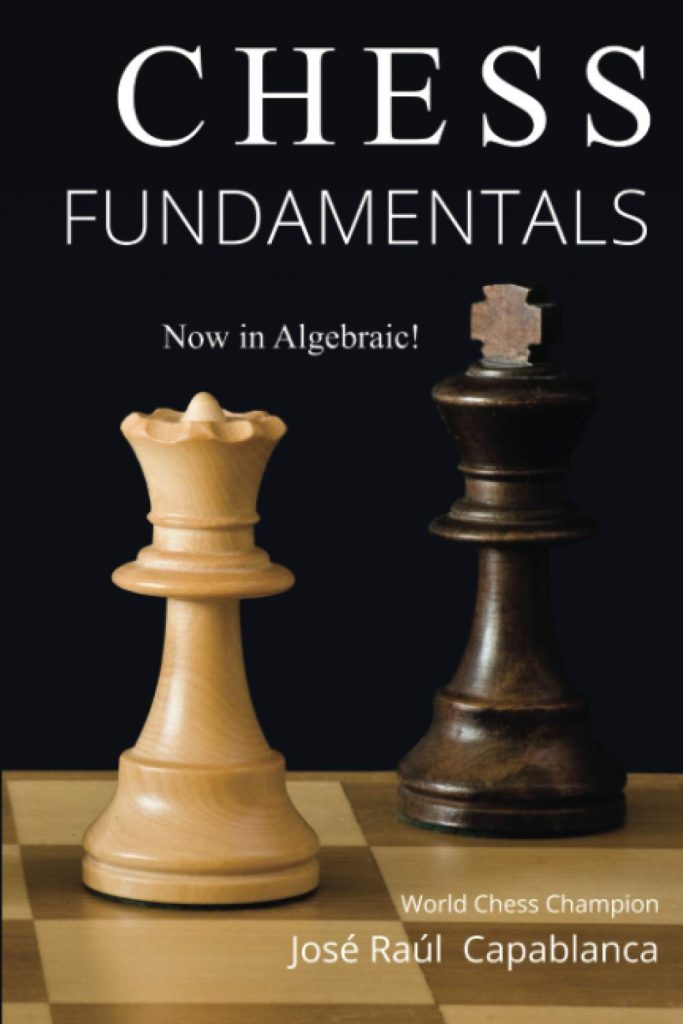
Another best seller chess book for novice players is Chess Fundamentals. It equips you with the essential opening, middle game, and endgame strategies to improve your game.
- The Soviet Chess Primer, Ilya Maizelis
This book has inspired generations of Russian chess players to take up and advance their game, including Anatoly Karpov and Garry Kasparov, the 12th and 13th chess world champions.
- The Complete Idiot’s Guide to Chess, Grand Master Patrick Wolff
Written byU.S. Chess Champion Patrick Wolff, this book includes information for players at all expertise levels. With over 400 illustrated chessboards and other images, this book is a great read if you wish to advance your gameplay.
- Play Winning Chess, Grand Master Yasser Seirawan
This book gives the readers an introduction to the moves, philosophy and strategies of chess. The examples, question and answer sections as well as clear explanations and images help provide a beginner with the basic foundations for playing chess.
- A First Book of Morphy, Frisco Del Rosario
This book illustrates the basic principles of chess with over 60 brilliant and instructive games played by the chess champion, Paul Morphy.
- Learn Chess Tactics, Grand Master John Nunn
Grand Master John Nunn guides the reader through key tactical ideas such as the fork, pin etc. He also discusses general ideas such as compulsion and elimination.
- Winning Chess Tactics, Grand Master Yasser Seirawan
Seirawan shows the readers how to put the tactics of the various world’s chess legends to use. You can learn various time tested tactics such as the skewer, the pin, double attack etc.
Conclusion
Chess is a game purely of Indian origin; a great tribute to Indian genius. In ancient India, it was known as Chaturanga, which means the four limbs or diversions of the ancient Indian army: infantry, cavalry, elephants and chariots. Those four divisions or limbs formed the army proper, flanking either side of the king and his chief minister or Mantri/vazir.

The objective of chess lies in eliminating the pieces from the opponent’s territory with a strategic advancement leading the opponent king to an inescapable position to be announced checkmate. Chess builds the mental abilities of a person helping him/her towards better strategies for life. It provides for the constant development of the human mind. You can develop a career as a professional chess player if you are passionate enough about this game. Chess players have been found to possess a higher spatial ability than others of comparable intelligence levels. They also possess greater physical endurance, together with a tolerance for frustration. For more information, visit Podium School.
Share with your friends
